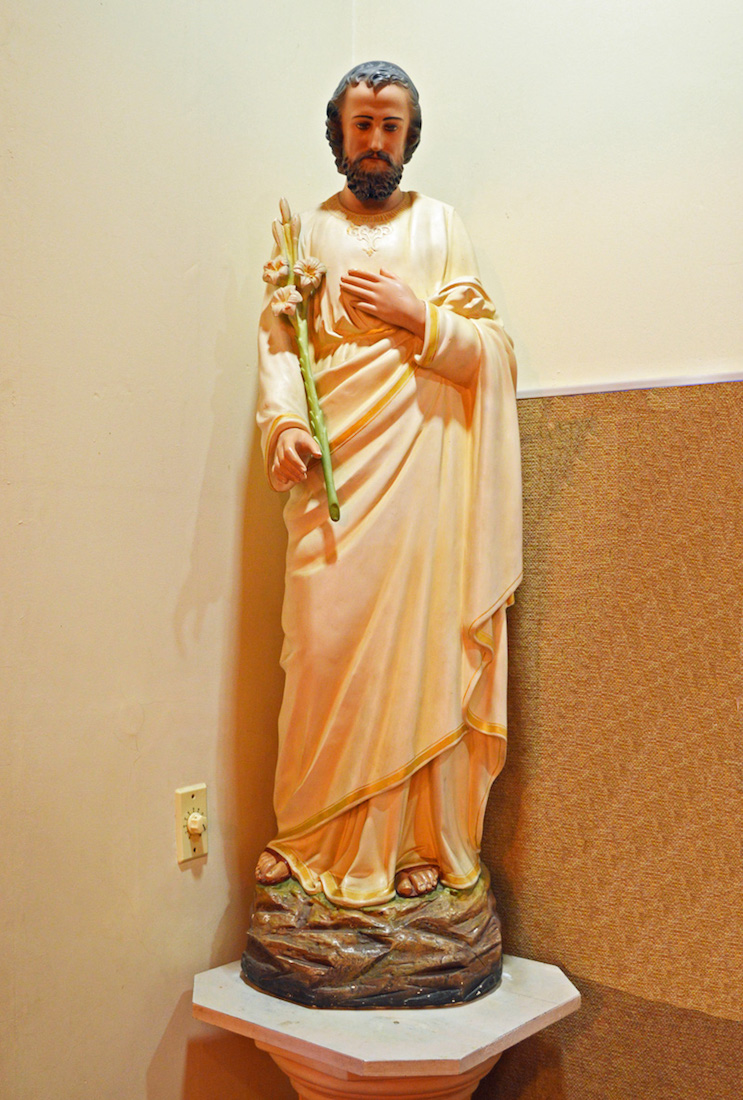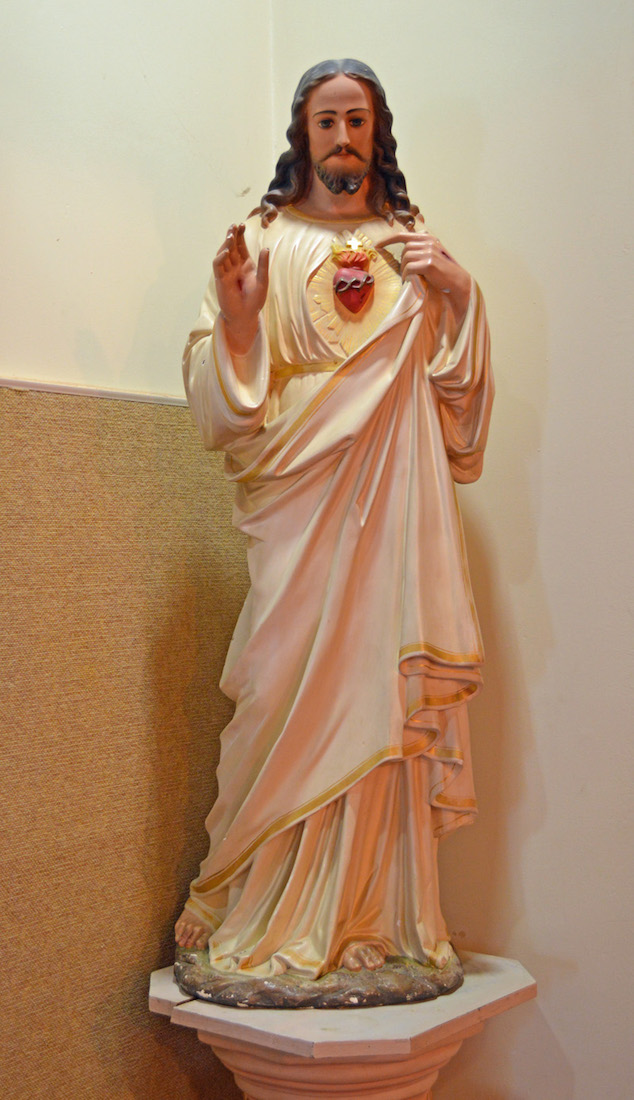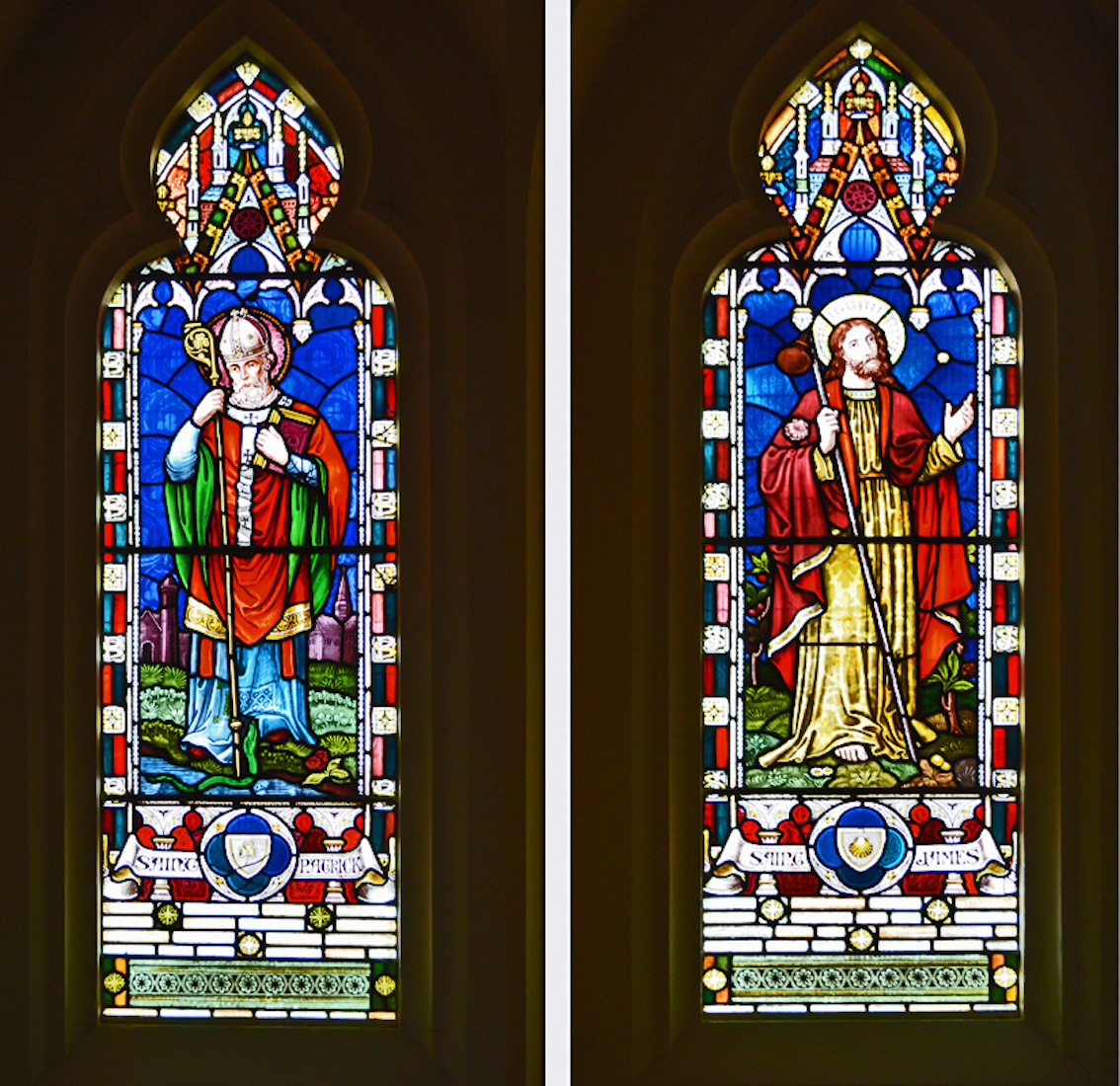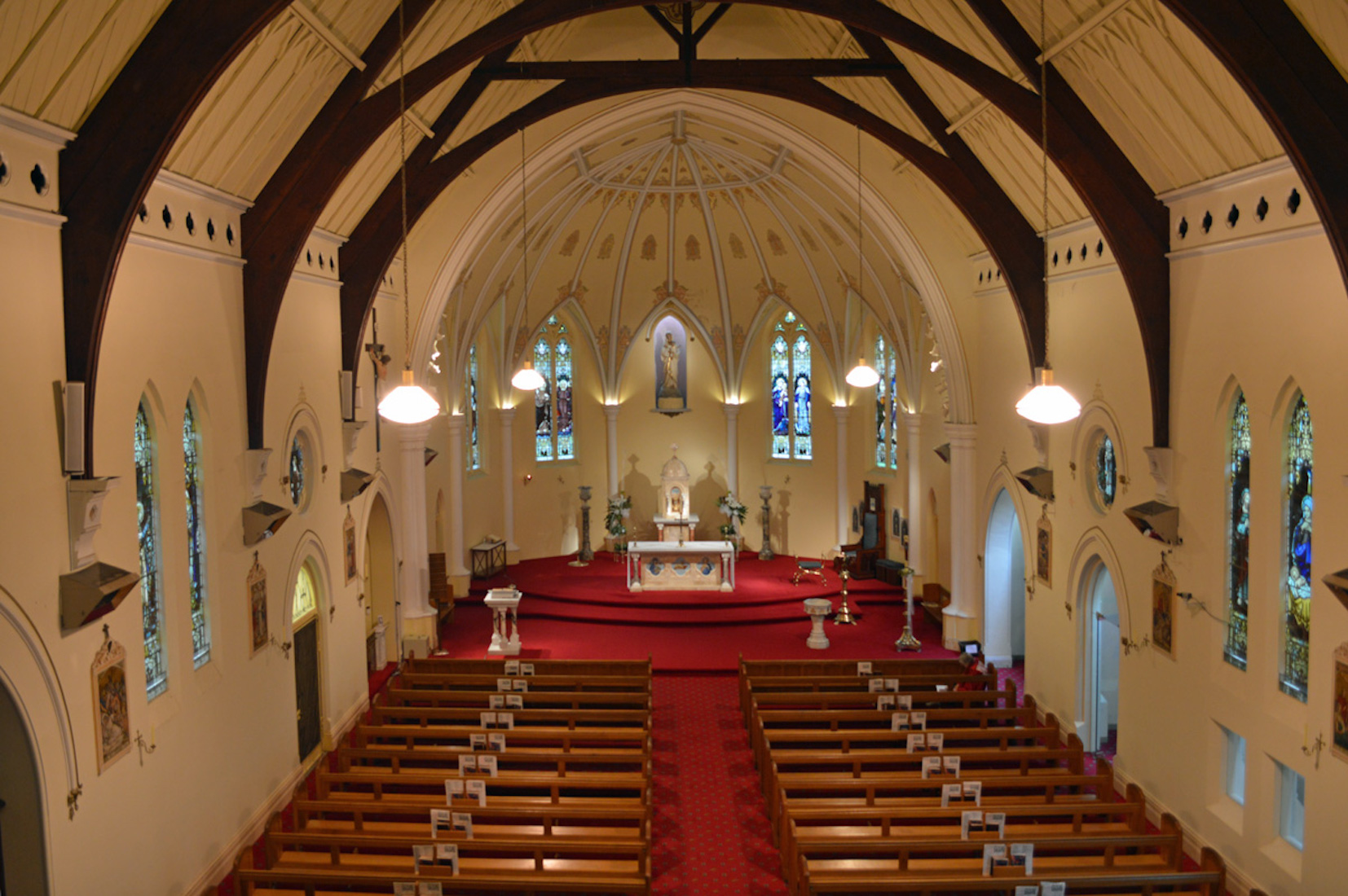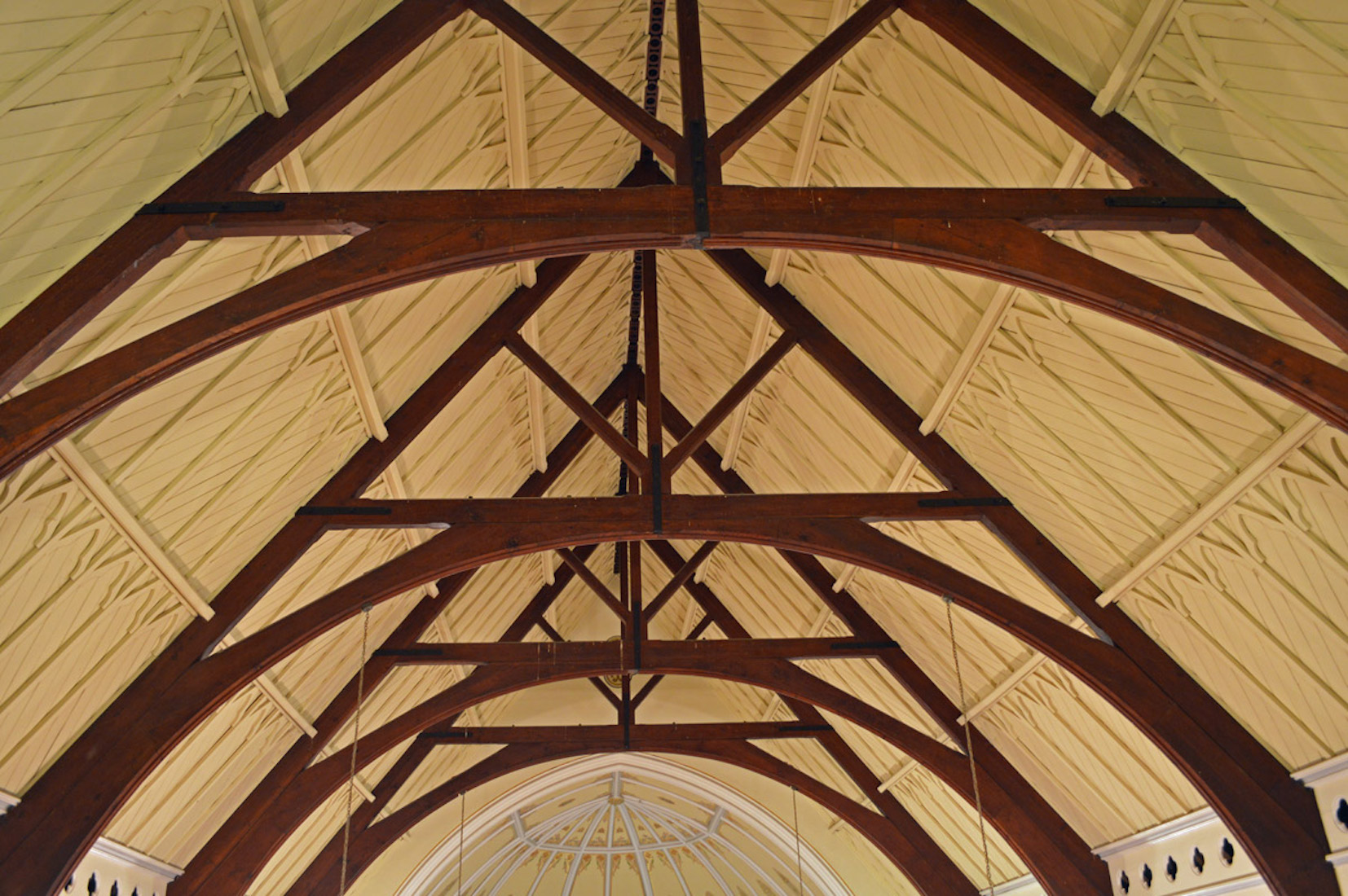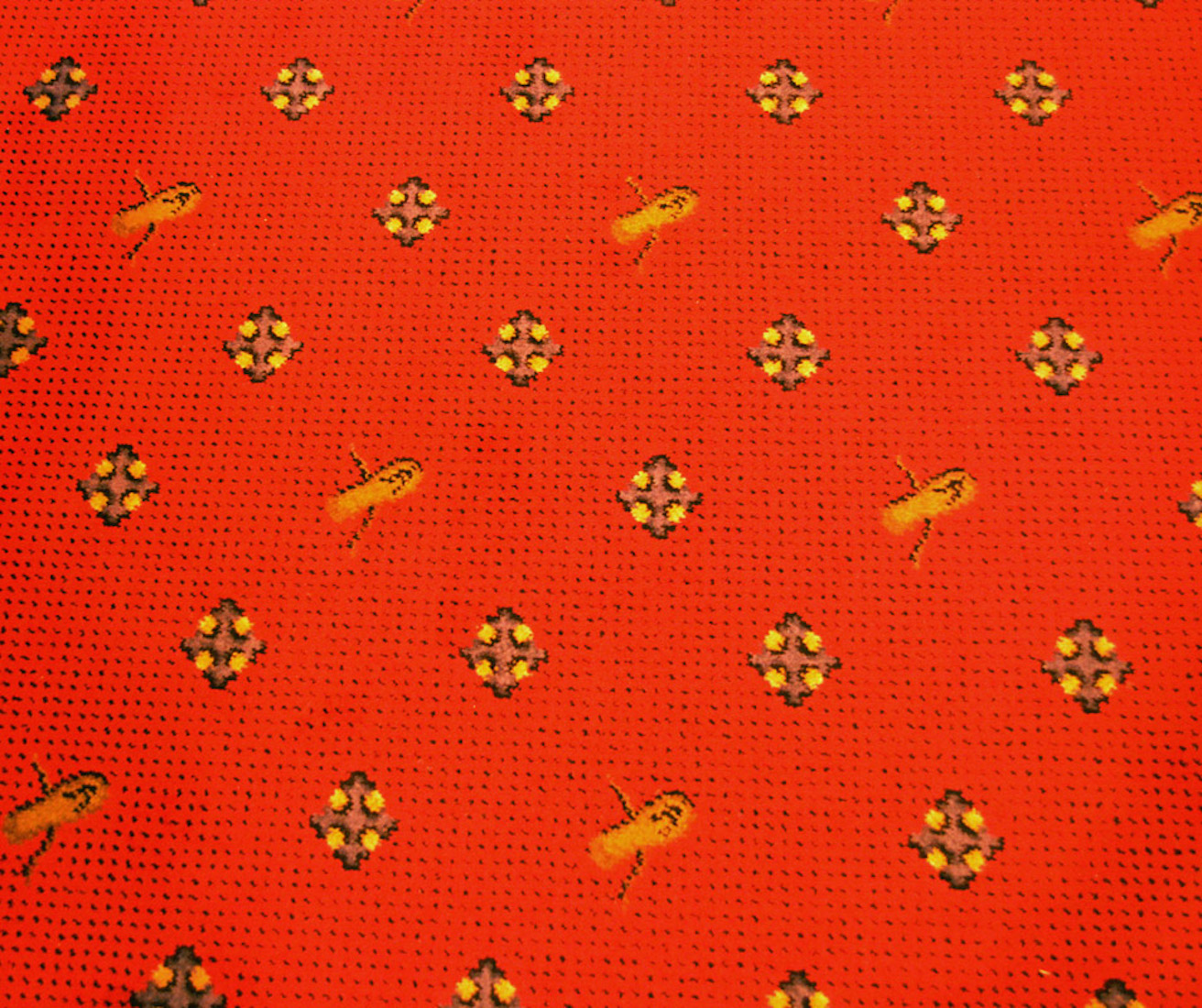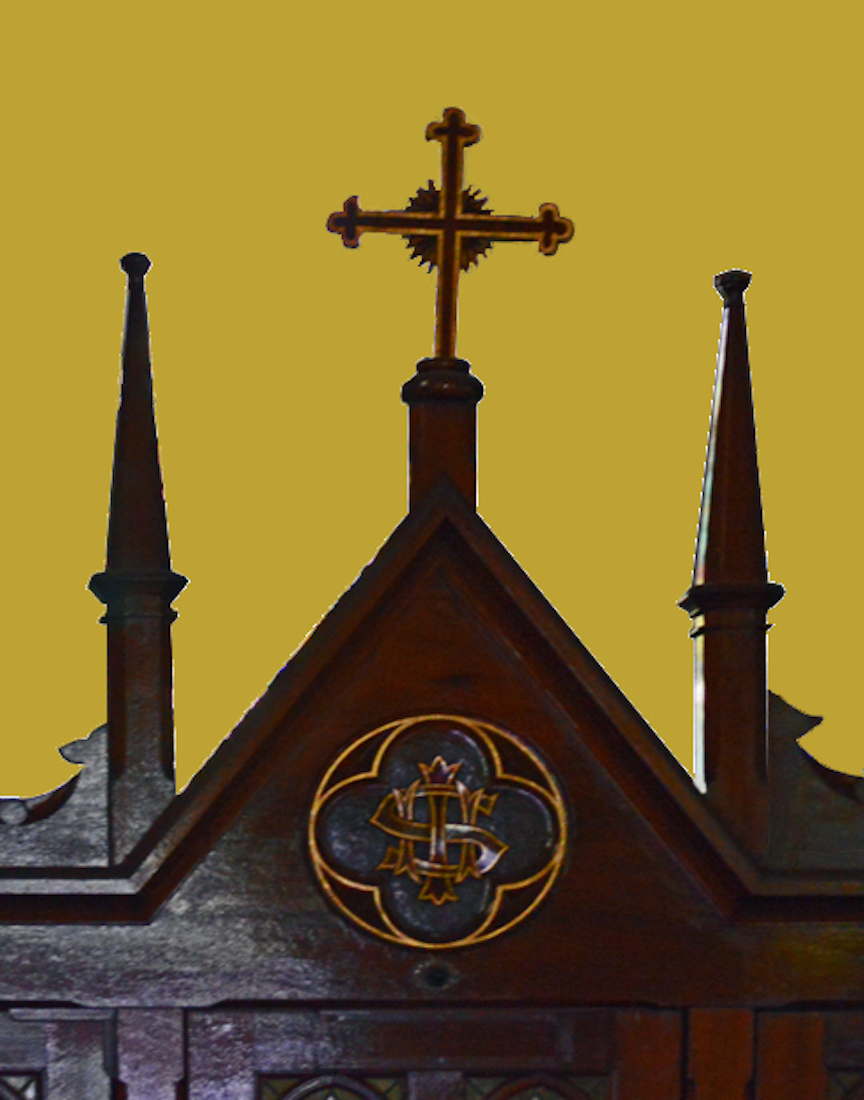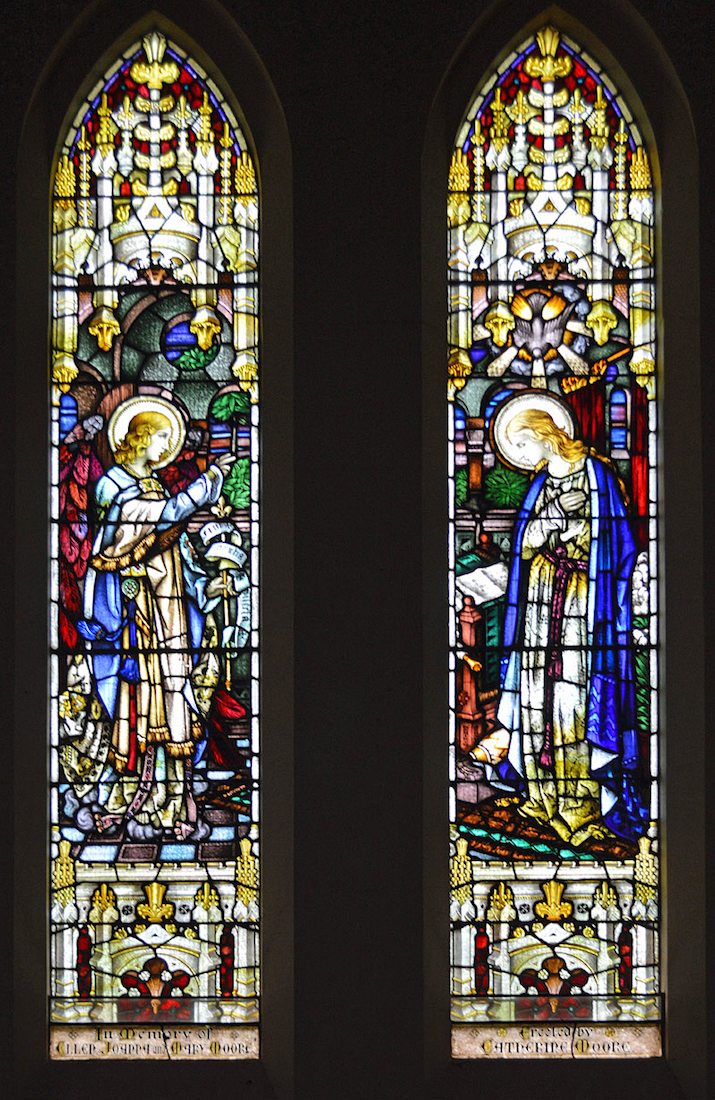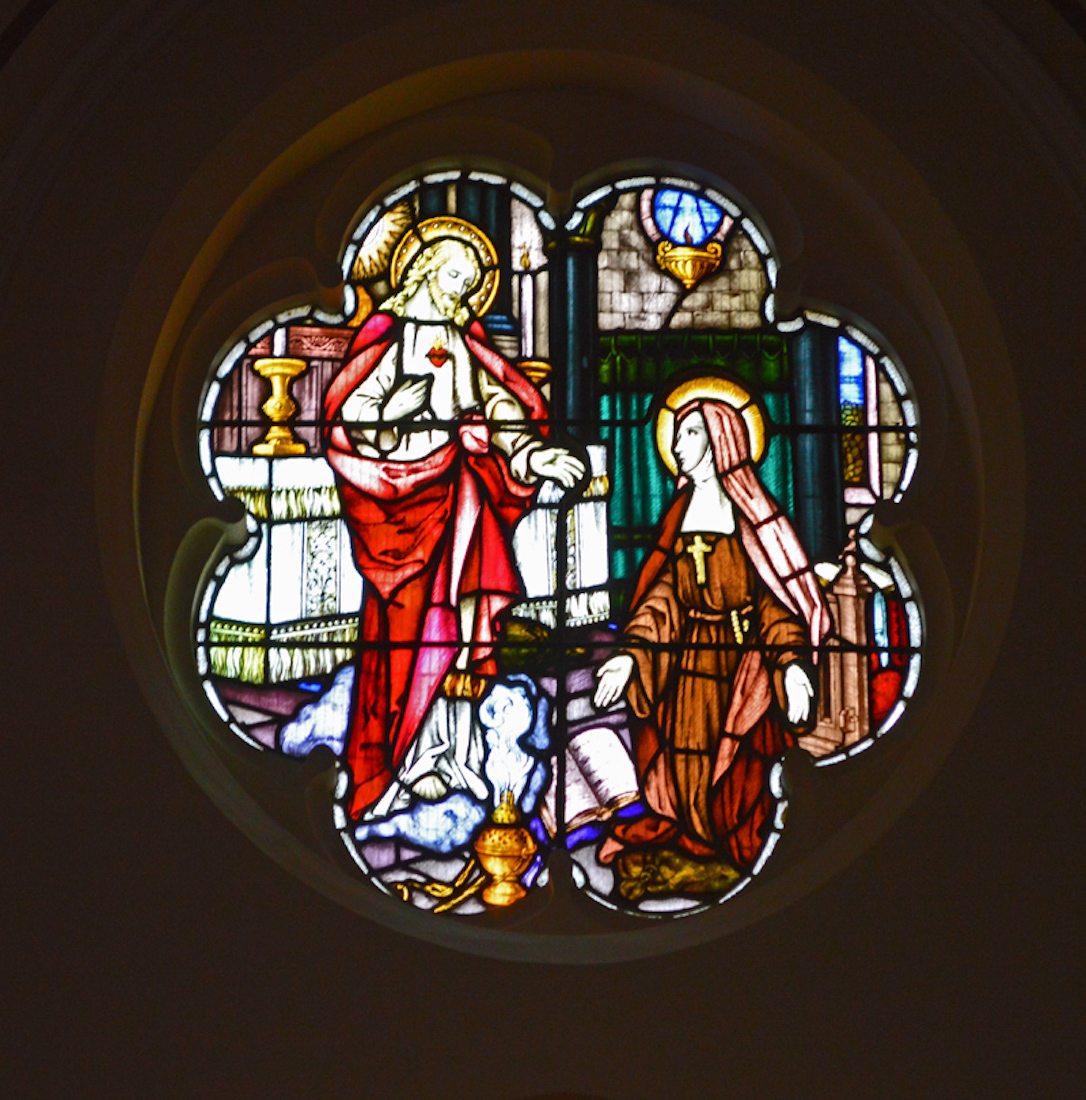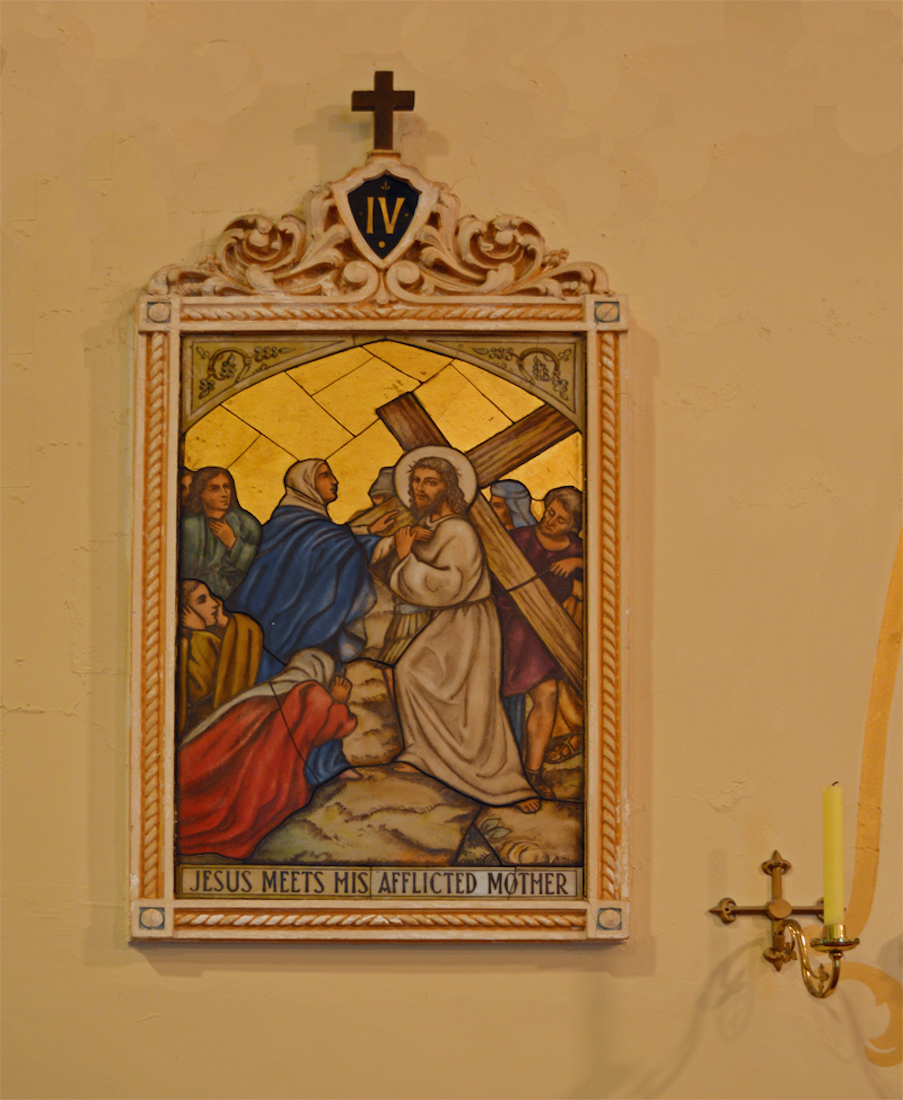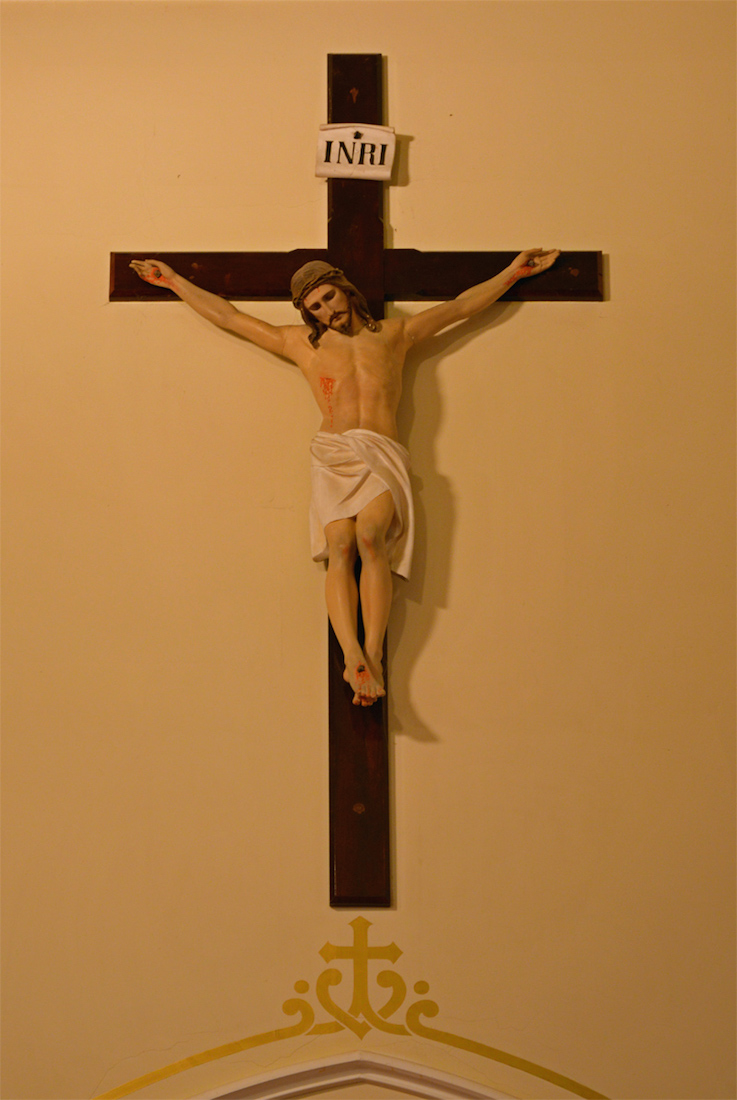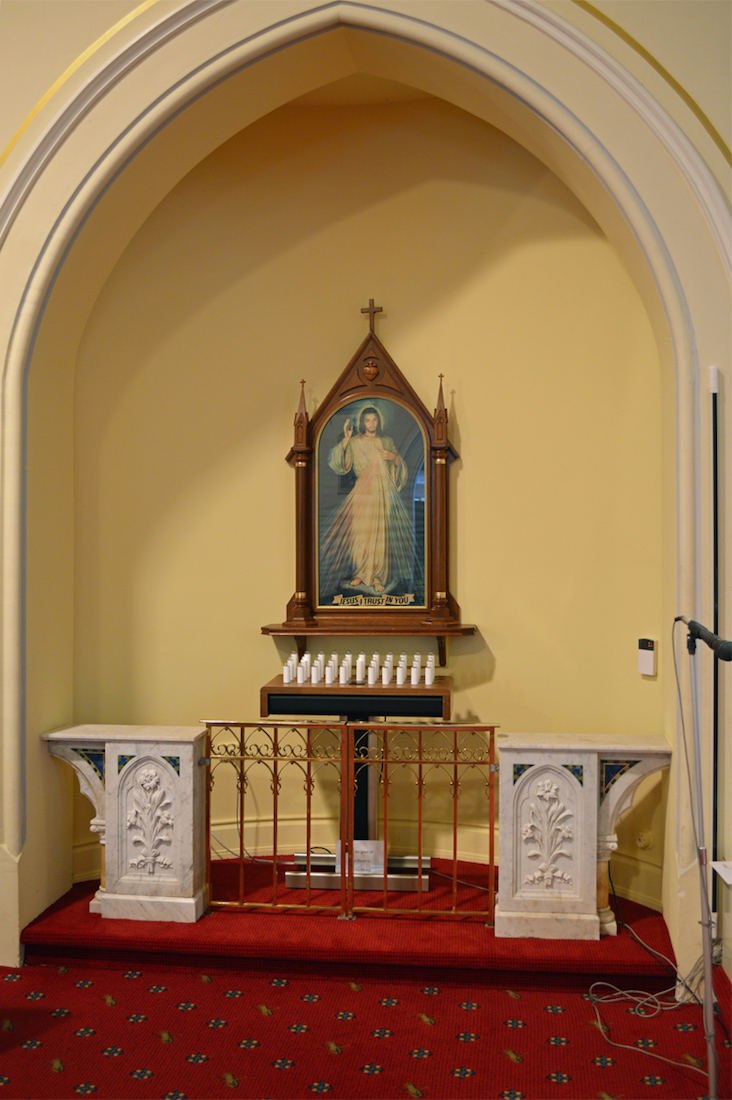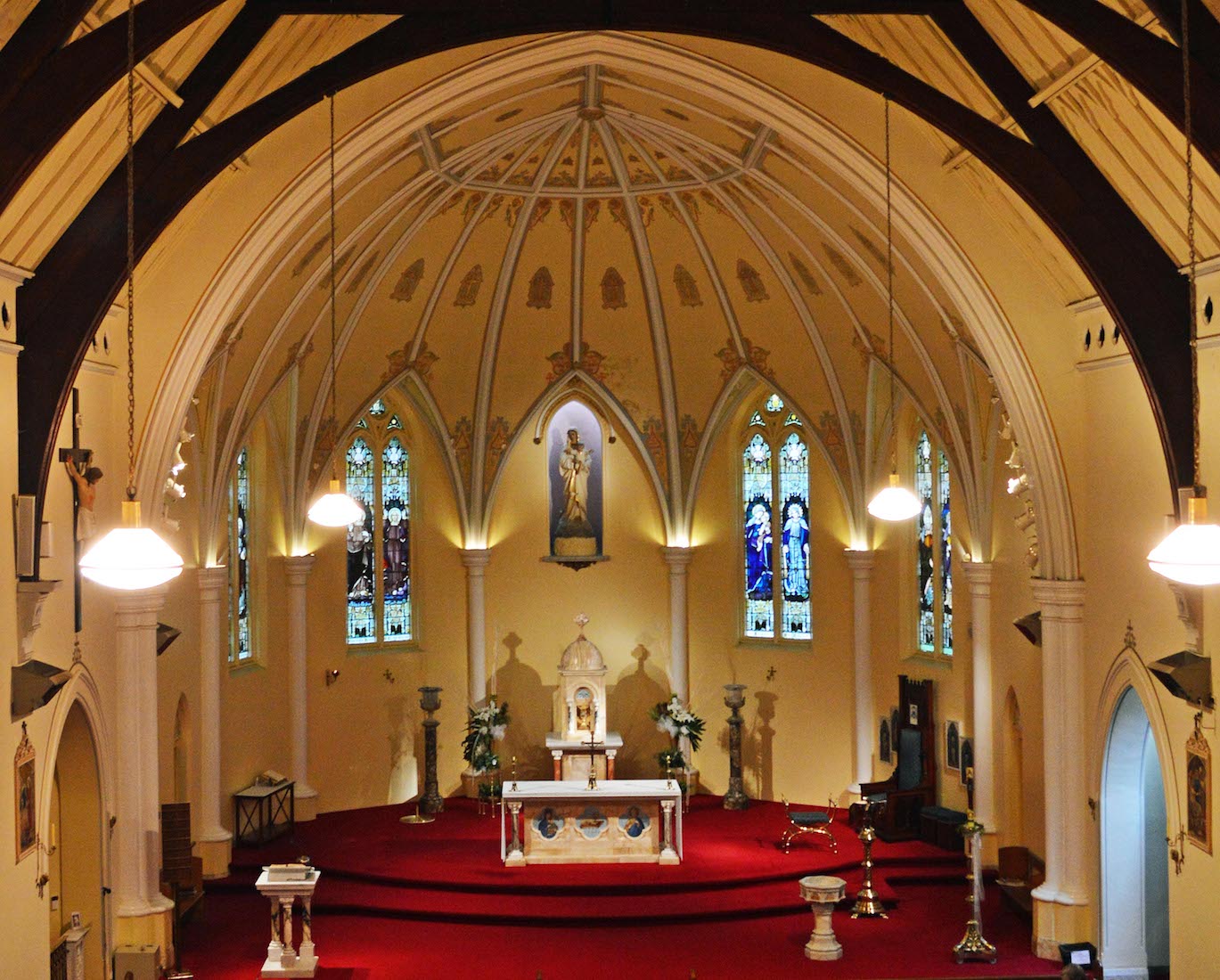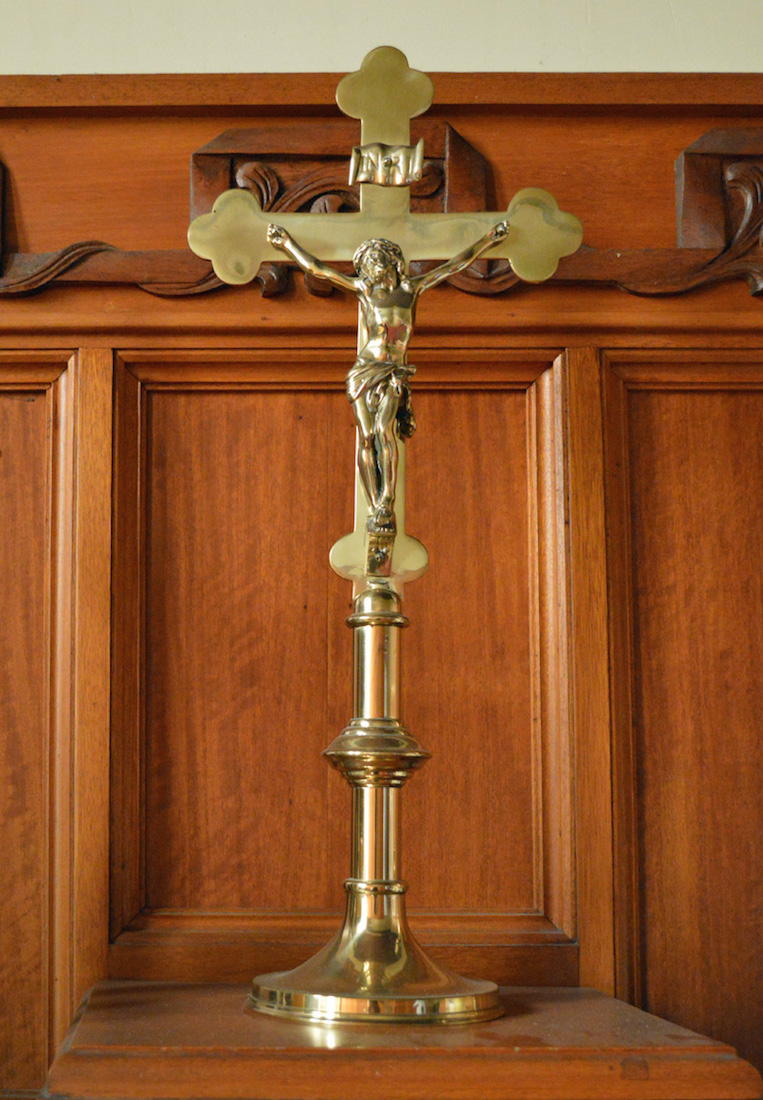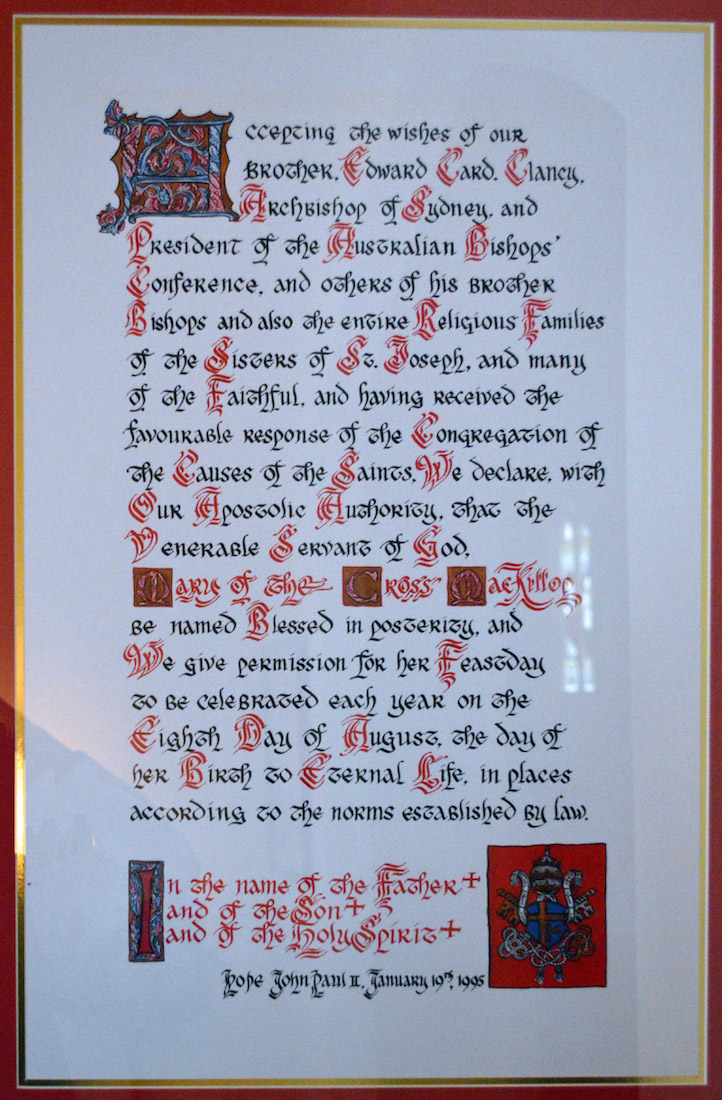
Opposite the Mary MacKillop sculpture is an ornamental scroll which reads: Accepting the wishes of our Brother Edward Card. Clancy, Archbishop of Sydney, and President of the Australian Bishops’ Conference, and others of his Brother Bishops and also the entire Religious Families of the Sisters of St Joseph, and many of the Faithful, and having received the favourable response of the Congregation of the Causes of the Saints, We declare with our Apostolic Authority, that the Venerable Servant of God, Mary of the Cross MacKillop be named Blessed in posterity, and We give permission for her Feastday to be celebrated each year on the Eighth Day of August, the Day of her Birth to Eternal Life, in places according to the norms established by Law. In the Name of the Father + and of the Son + and of the Holy Spirit + Pope John Paul II, January 19th, 1995 PLAN
22. NARTHEX WINDOW
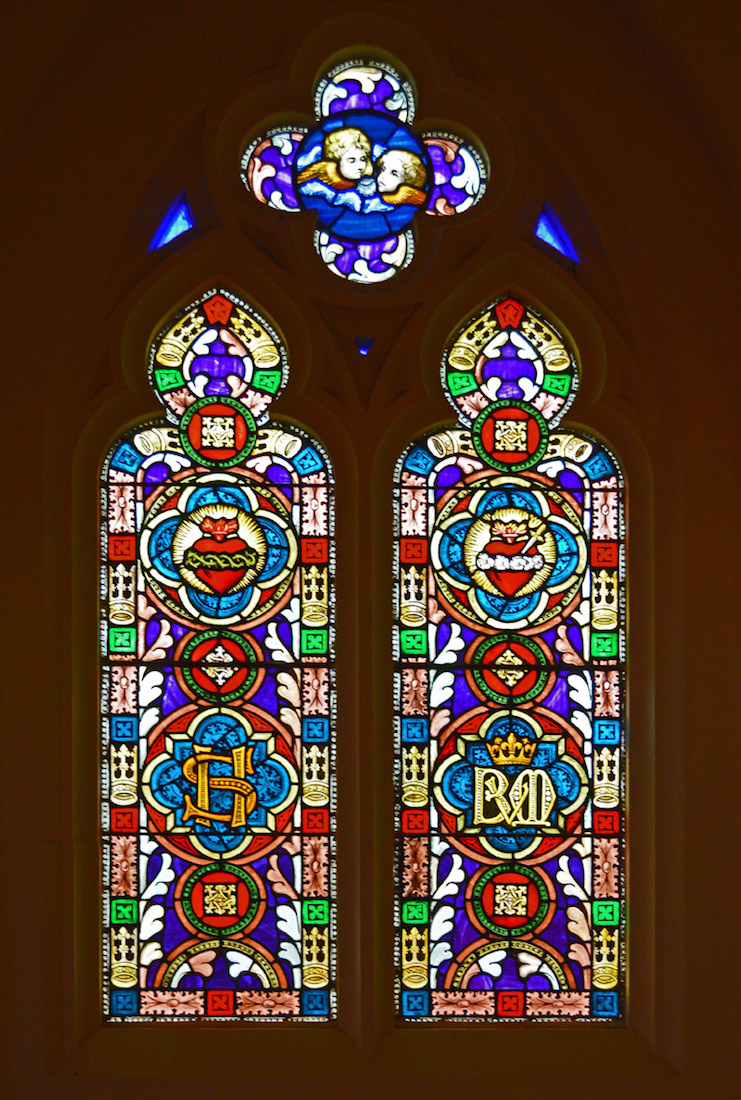
This is the window in the narthex of the Cathedral. It pictures various Catholic symbols including the Sacred Heart, the BVM (Blessed Virgin Mary), and a stylized Christogram IHS (the first three letters of the name ‘Jesus’ in Latinised Greek).
23. WEST NAVE
Entering the nave and looking back towards the West wall, we notice the three stained glass windows, the statues of St Joseph (left) and the Sacred Heart (right), and the fine organ. The organ was installed to one side of the rear gallery and was first used at Christmas 1903. The local newspaper reported: ‘The new pipe organ recently installed at St. Mary’s Cathedral which was generously donated by His Lordship The Rev. Dr. Corbett, was played for the first time on Christmas Day. It is a fine instrument, and will make a handsome addition to the Cathedral.’
24. ST JOSEPH
Just inside the entryway stands this statue of St Joseph, easily recognizable by the lily he is carrying. The lily is associated with St. Joseph, spouse of Mary, through an ancient legend that he was so chosen from among other men by the blossoming of his staff like a lily. Likewise, the biblical passage, ‘The just man shall blossom like the lily’ is applied to St. Joseph in the liturgy of the Roman Catholic Church for his feastday, March 19.
25. SACRED HEART
Across in the North Western corner of the nave stands a statue of the Sacred Heart. The Sacred Heart (also known as Most Sacred Heart of Jesus) is one of the most widely practiced and well-known devotions, taking Jesus’ physical heart as the representation of his divine love for humanity. This devotion is predominantly used in the Catholic Church and among some high-church Anglicans and Lutherans. The devotion especially emphasizes the unmitigated love, compassion, and long-suffering of the heart of Christ towards humanity. The origin of this devotion in its modern form is derived from a French Roman Catholic nun, Marguerite Marie Alacoque, who said she learned the devotion from Jesus during a mystical experience.
26. WEST WALL WINDOWS
The two colourful smaller West wall windows of the Nave are shown here side by side. The left window depicts Saint Patrick, the right one St James.
28. NAVE ROOF
The interior roof of the nave is a simple structure: cream patterned panels supported by dark brown timber beams and arches.
29. NAVE CARPET
The Cathedral carpet was especially designed in 1993 to include the motif of a sandal. This is in reference to the dangling sandal of the baby Jesus in the Lady of Perpetual Help window in the Assembly Area. (The Lady of Perpetual Help is Patroness of the Diocese.) It is a nice touch, but we might wonder why this particular symbol was chosen ... .
30. NORTH NAVE
As we begin our walk along the North wall of the nave, let’s navigate! There are two pairs of Gothic-like windows, and in the distance a rose window. Various Stations of the Cross adorn the wall, and there is a large Crucifix in the distance. Centrally, there is an arch containing a recessed confessional. We now investigate these in detail ...
31. NORTH WINDOWS WEST
There are four pairs of stained glass windows in the nave. They were commissioned in 1933, and are themed on the Joyful Mysteries of the Rosary. Each pair of windows carries a dedication suggested by the benefactor. This pair of windows depicts the Presentation in the Temple. The left Allman window was presented by Elizabeth May Allman in memory of her husband John, grazier and dealer, and her Killeen parents. The right O’Connor window is in memory of Grace O’Connor, the wife of stationmaster Michael O’Connor.
32. CONFESSIONAL
Half way down the Northern nave wall, we come to the confessional, set into an arch. The confessional is interesting in its shape, which emulates the Western gable of the Cathedral with its twin towers. Below the ornate cross is a decorative version of the IHS symbol, a common Christogram based on the first three letters of ‘Jesus’ in Greek.
33. NORTH WINDOWS EAST
The Moore windows depict The Annunciation, and were presented by Catherine Moore in memory of her sisters. The Moore sisters lived in the former ‘Mary Grant Bruce’ property near Sale. Their father, William, a prominent figure in the Indian remount (horse) trade, owned the celebrated Tooloonook property near Yarram. Catherine Moore, the last surviving sister, died in 1939.
34. ROUND WINDOW
The round window in the Northern wall of the nave was also commissioned in 1933. It shows Sister Margaret Mary Alacoque, chief founder of devotion to the Sacred Heart, who was canonized in 1920.
35. STATION IV
Around the year 1938, the then Bishop of Sale, Most Rev. Richard Ryan C.M. decided to erect a new set of Stations of the Cross worthy of the Cathedral. He expressed a wish for colour, but not in the medium of plaster. Two excellent artists, Alan Sumner and William Frater were located, and several sketches were made of hand painted and coloured ceramics. After much debate the final decision was made for the Stations which appear in the Cathedral today.
36. WALL CRUCIFIX
High on the North wall at the East end of the nave hangs a large crucifix. A photograph of the funeral Mass for Bishop Ryan, held in 1957, shows this crucifix hanging in much this position.
37. SHRINE
A shrine is recessed into an archway at the East end of the Northern nave wall, beneath the high Crucifix. It features a painting of Our Lord with the words beneath ‘Jesus I trust in You’.
38. SANCTUARY
We take a moment to review our progress. At left is the Crucifix above the shrine alcove. In front of the sanctuary platform are an ambo, font, lectern and Paschal candle. There are four two-lancet windows and a central statue of Our Lady. Below is the altar and tabernacle, and the cathedra at right.
39. SANCTUARY NORTH WINDOW
On the East Wall behind the Sanctuary are a pair of stained glass windows presented by Denis O’Brien of Cowwall(?). The left panel shows Jesus of the Sacred Heart. The right panel appears to show the resurrected Lord.
40. SIDE CRUCIFIX
Off the North side of the sanctuary and out of general public view, is a little store room containing a number of little treasures, including this wonderful golden Crucifix. At the top of the Cross is the inscription INRI. This is an acronym standing for Iēsus Nazarēnus, Rēx Iūdaeōrum, and represents the Latin inscription which in English reads as “Jesus the Nazarene, King of the Jews”.



